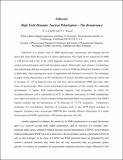High field dynamic nuclear polarization—the renaissance
Author(s)
Griffin, Robert Guy; Prisner, T. F.
Download1_PCCP_Editorial_V1_TP.pdf (966.5Kb)
OPEN_ACCESS_POLICY
Open Access Policy
Creative Commons Attribution-Noncommercial-Share Alike
Terms of use
Metadata
Show full item recordAbstract
Sensitivity is a critical issue in NMR spectroscopy, microscopy and imaging, and the factor that often limits the success of various applications. The origin of low sensitivity in NMR is well known to be due to the small magnetic moment of nuclear spins, which yields small Boltzmann polarizations and weak absorption signals. Historically, each advance in technology and methodology that has increased the signal-to-noise in NMR has shifted the boundary of what is achievable, often opening new areas of application and directions of research. The archetypal example of this phenomenon was the introduction of Fourier transform spectroscopy which led to increases of ~10[superscript 2]-fold in signal-to-noise, revolutionizing NMR and many other forms of spectroscopy. More recent technological developments of note include the continuing development of higher field superconducting magnets which increases polarization, and cryoprobes in which the excitation/detection coil is maintained at low temperatures increasing sensitivity through a higher probe Q and decreasing receiver noise. In addition, innovations in NMR methodology have improved sensitivity, classic examples being Hartmann–Hahn cross polarization, and J-coupling meditated transfer methods, and the introduction of 1H detection of [superscript 13]C/[superscript 15]N resonances. Furthermore, techniques for non-inductive detection of resonance, such as the AFM-based technique of magnetic resonance force microscopy (MRFM), have recently allowed observation of a single electron spin, and ~100 nuclear spins/√Hz[superscript 8].
Date issued
2010-05Department
Francis Bitter Magnet Laboratory (Massachusetts Institute of Technology)Journal
Physical Chemistry Chemical Physics
Publisher
Royal Society of Chemistry, The
Citation
Griffin, R. G., and T. F. Prisner. “High Field Dynamic Nuclear Polarization—the Renaissance.” Physical Chemistry Chemical Physics 12.22 (2010): 5737.
Version: Author's final manuscript
ISSN
1463-9076
1463-9084